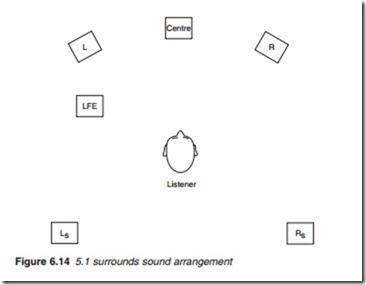Surround sound
Stereo has been a mainstream consumer format for more than 40 years, and so it is not surprising that there has been search for new techno- logies that further enhance the listener experience. Along with other types of refinements, such as longer audio sample word lengths and higher sampling rates, what is known as high resolution audio, the move towards multi-channel audio or surround sound has become a practical possibility. Consumers can buy inexpensive 5.1-channel play- back systems and even 7.1 channel systems are becoming common. However, a non-disruptive transition from stereo to multi-channel audio requires media formats that can serve both those using conventional stereo equipment and those using next-generation multi-channel equip- ment. While some recent consumer media, such as DVD-video, DVD- audio and super audio CD, resolve the problem by storing both stereo and multi-channel versions of the sound material, this is not a viable option for applications that have to work under severe channel band- width limitations, such as digital audio and TV broadcasting or Internet streaming.
The new MPEG surround provides an efficient bridge between stereo and multi-channel presentations in low-bit rate applications with com- plete backward compatibility with non-multi-channel audio systems. Legacy receivers decode an MPEG surround bitstream as stereo, enhanced receivers provide multi-channel output. It employs the tools available in AAC but introduces a technique for incorporating multi-channel sur- round sound.
Delivering more than two channels with analogue systems is difficult, however, the Dolby surround system managed to do this by encoding the two rear channels into the standard stereo signals. In the digital field, any number of channels may be encoded and multiplexed. The problem is the bit rate requirements.
MPEG surround coding techniques overcome these shortcomings by including spatial parameters as part of the sound bitstream.

